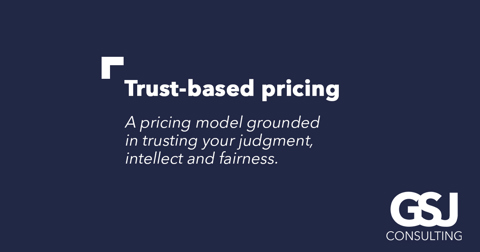Trust-based pricing: when relationships set the price

For some time now, we have been told that the onset of artificial intelligence (AI) will doom the billable hour and that value-based pricing is the future. But what if they are wrong? Not about the end of the billable hour - that may still happen. But that there’s another, often overlooked pricing model that can be just as, if not more powerful than value-based pricing: trust-based pricing.
What is trust-based pricing?
As the name suggests, trust-based pricing occurs when a client agrees to your fee not because they’ve benchmarked it against competitors or calculated the return on investment (value), but because they trust you. They trust your judgment, your intellect, your fairness and your commitment to their outcomes.
It’s a model grounded in confidence and long-term perspective. Clients who operate on trust-based pricing don’t need line-by-line justifications of hours spent or ROI delivered. Instead, they believe that you’ll “do right by them” because you have a track record of consistency, reliability and transparency.
How does trust-based pricing differ from value-based pricing?
At first glance, trust-based pricing and value-based pricing look similar. Both move you away from the tyranny of the billable hour and toward a model where clients focus on outcomes rather than inputs. But the distinction between these two pricing mechanisms lies in what drives the client’s willingness to pay.
Value-based pricing
Price is anchored in economic logic. The client asks, “What is this worth to me?” and pays in proportion to measurable impact: cost savings, revenue growth or risk avoided. Communicating this model requires a deep understanding of the economic value you are bringing to the transaction/relationship. Often, it requires a business case to be completed.
Trust-based pricing
Price is anchored in relational logic. The client asks, “Do I believe you’ll treat me fairly and deliver what I need?” It’s less about the dollar value of the outcome and more about the confidence that the professional will act in their best interest.
While both of these pricing models can coexist, if you really are the trusted advisor to your client, then arguably trust-based pricing is the more favourable option as it is sustained by reputation, transparency and relationship equity. If, on the other hand, your relationship with the client is not strong, then arguably value-based pricing is the more favourable option as it is sustained by the quantifiable outcomes you will provide.
Why trust matters more than you think
Most professional services firms purport to be the ‘trusted advisor’ of their clients. But the reality is that most professionals are not the trusted advisor to their client unless the client sees:
- Predictability: They know there will be no nasty surprises when the invoice arrives.
- Fairness: They believe you won’t exploit information asymmetry.
- Commitment: They trust you’ll put their interests first, even if that means extra effort on your side.
The Holy Grail here is that when clients trust you, they stop scrutinising every billable unit you charge (because, frankly, you are not charging for every billable unit!).
Building the foundations of trust-based pricing
Just as value is in the eye of the beholder, trust isn’t given, it’s earned. For trust-based pricing to work, at a minimum, you need to invest in the following:
- Transparency: Be clear about what is (and isn’t) included. No hidden fees. No vague scopes.
- Consistency: Deliver the same high quality every time. Consistency builds predictability, which builds trust.
- Communication: Keep clients informed. Silence breeds suspicion. Regular updates, even if brief, show accountability.
- Empathy: Show you understand their pressures and constraints. Clients must feel you’re on their side, not just selling a service.
- Risk-sharing: Where appropriate, demonstrate willingness to align your interests with theirs; for example, tying a portion of fees to milestones or outcomes.
These practices signal integrity. And as we know, integrity is the currency of trust.
The risks of trust-based pricing
Like any model, trust-based pricing isn’t foolproof. The biggest risk is complacency. If quality slips or responsiveness declines, trust erodes, and with it, the entire pricing model.
In a nutshell
Trust-based pricing reminds us that, at its core, professional services is a people-to-people business. While economic logic matters, most clients are guided as much by emotion and relationship as by spreadsheets and ROI.
If you can combine trustworthiness with a clear demonstration of value, you’ll not only protect your margins but you’ll also create client relationships that last far beyond the next billable unit.
Further reading
Contact GSJ Consulting
We can help you Aquire, Retain, Grow
The information contained in this article is of general nature and should not be construed as professional advice. If you require further information, advice or assistance for your specific circumstances, please contact us.
